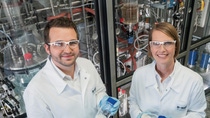Who we are
Our Research and Development
Effective and efficient R&D is a prerequisite for innovation. We are well positioned: With approximately 10,000 employees around the globe, we work on sustainable solutions for our customers every day. We benefit from the growing opportunities that digitalization and supercomputing power offer us.
Our most recent topics and highlights
Our global R&D network
Our central research division combines expertise in areas such as chemical synthesis, process development, bioscience, catalysis, analytics and digitalization and is globally organized with research centers in Europe, North America and Asia Pacific. Together with our business- and application-driven research units and development units in our operating divisions, it forms the core of our global Know-How Verbund.
Another important part of this Verbund is our global network of top universities, research institutes and companies. It gives us direct access to external scientific expertise, talented minds from various disciplines as well as new technologies – and helps us to quickly develop targeted, marketable innovations, strengthen our portfolio with creative new projects, and in this way, reach our growth targets.
Our academic research alliances bundle partnerships with several research groups in a region or with a specific research focus.
In our Safety Engineering Laboratory we deliver high-quality data and expert analysis to support the development and evaluation of robust safety concepts.


